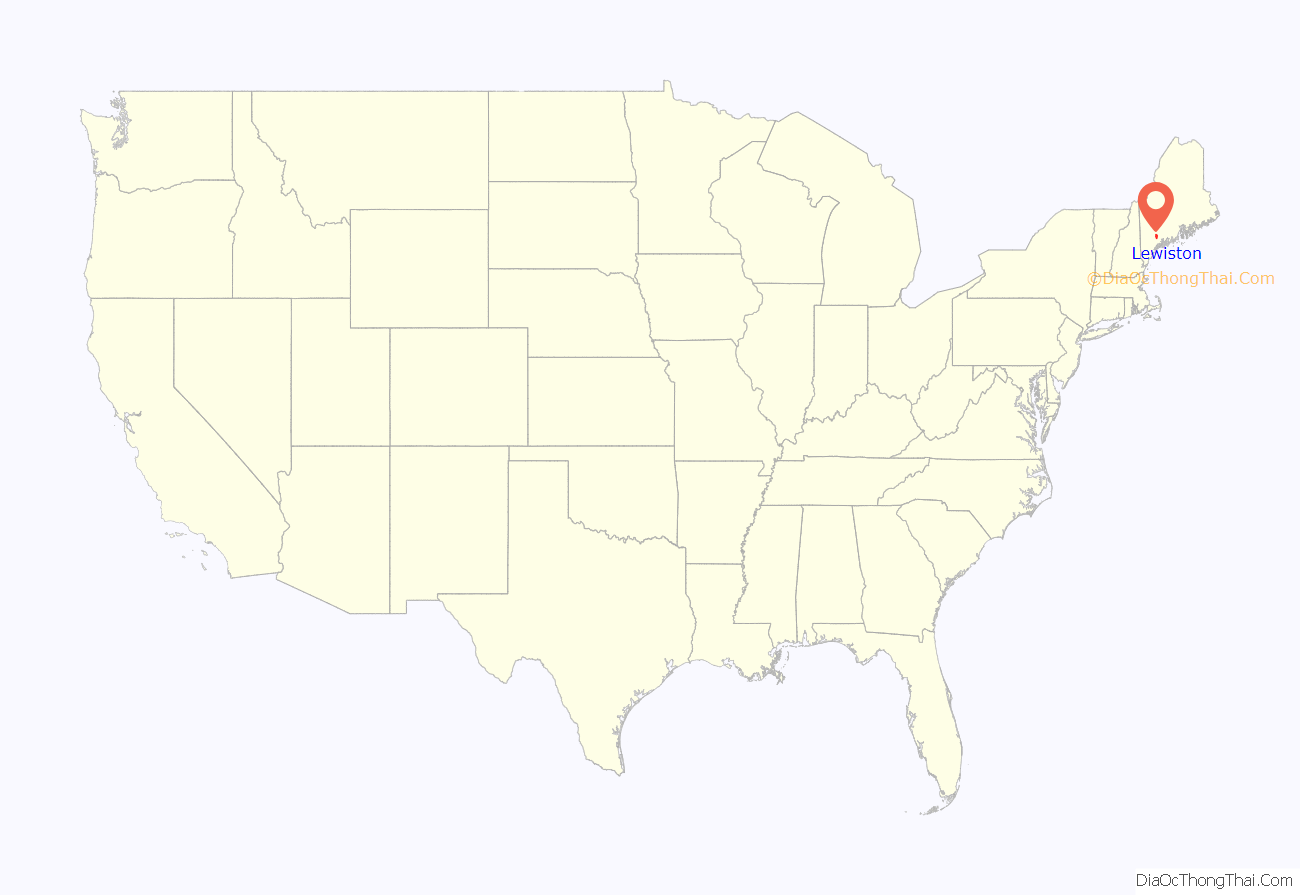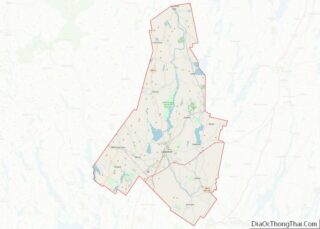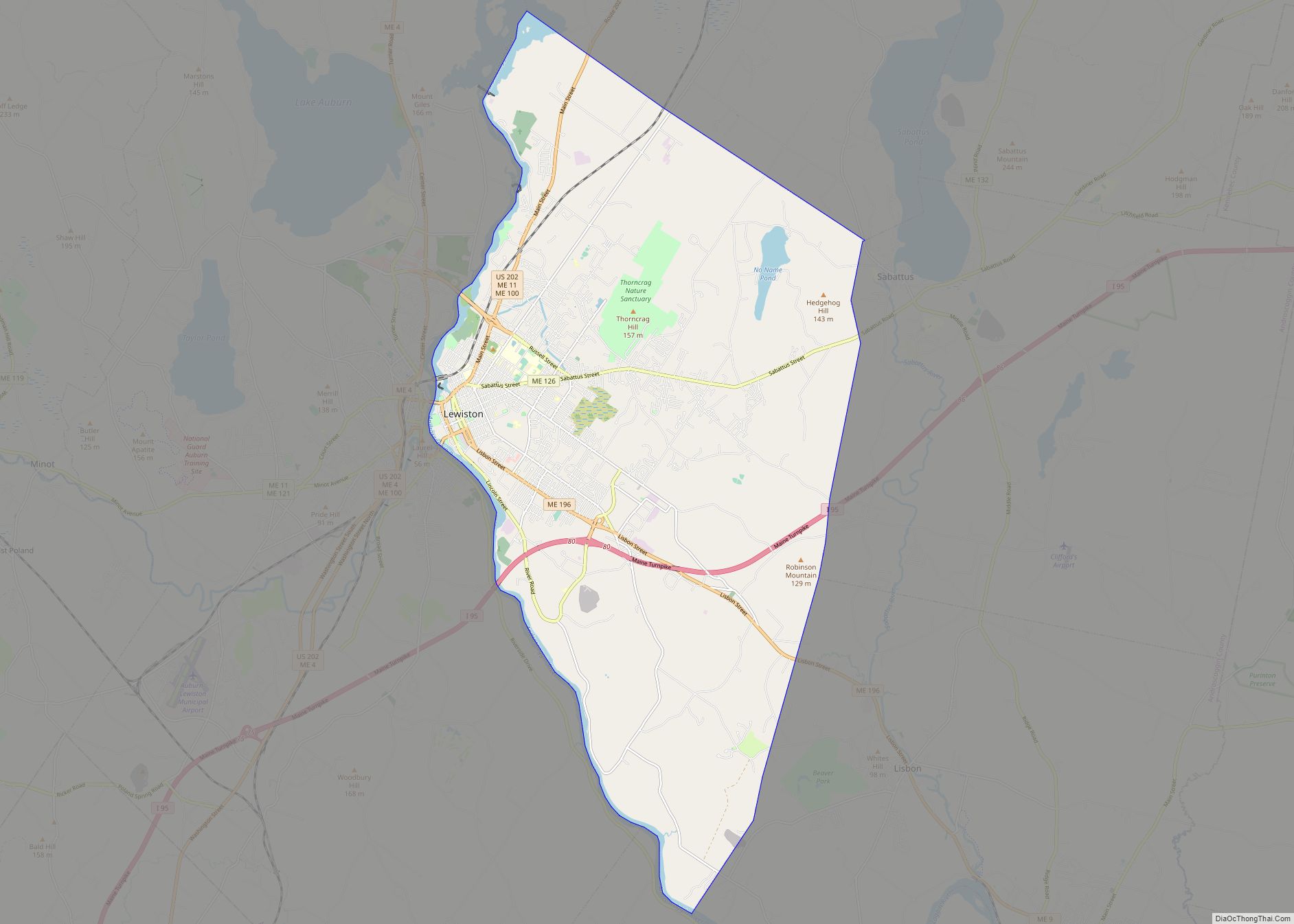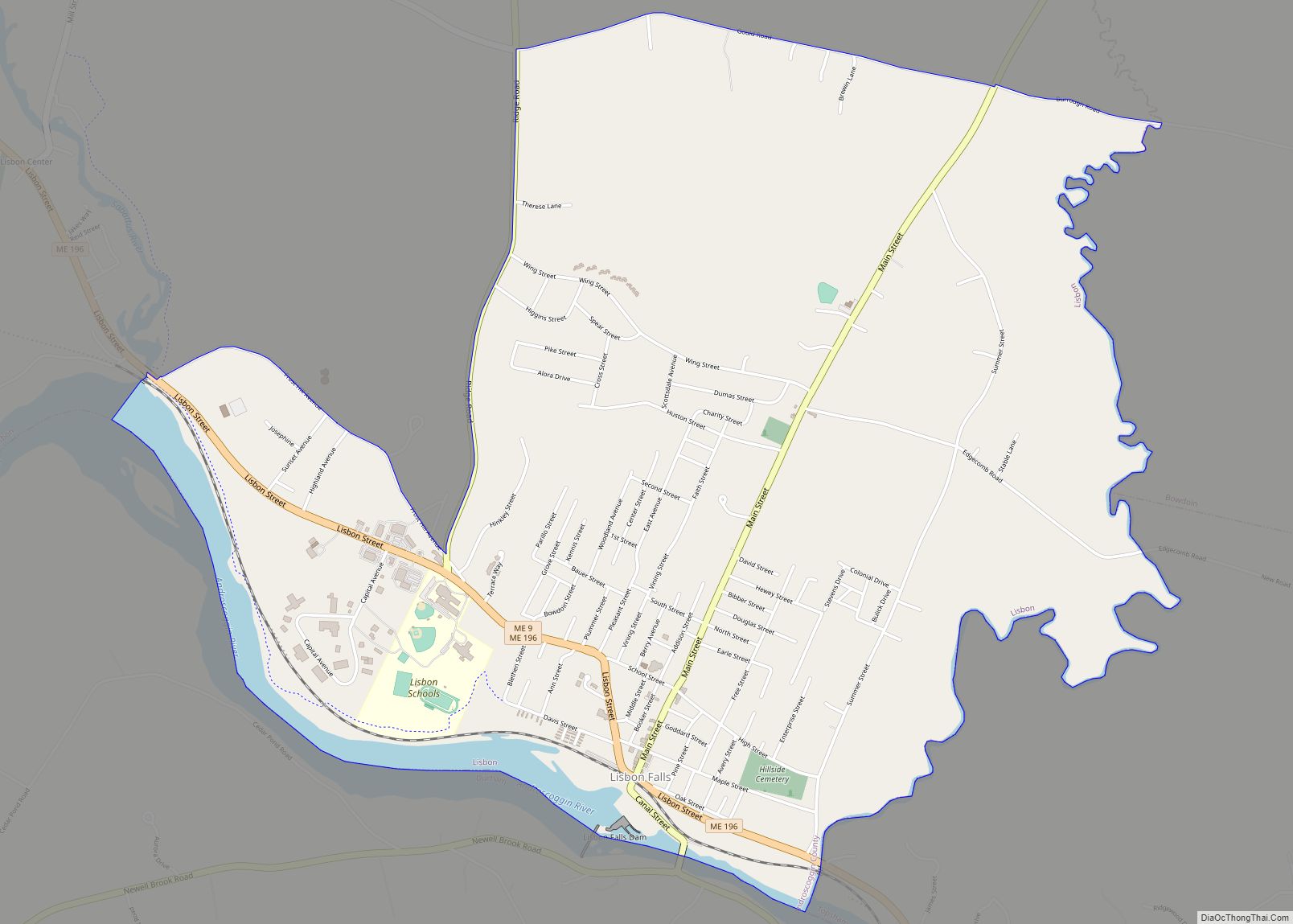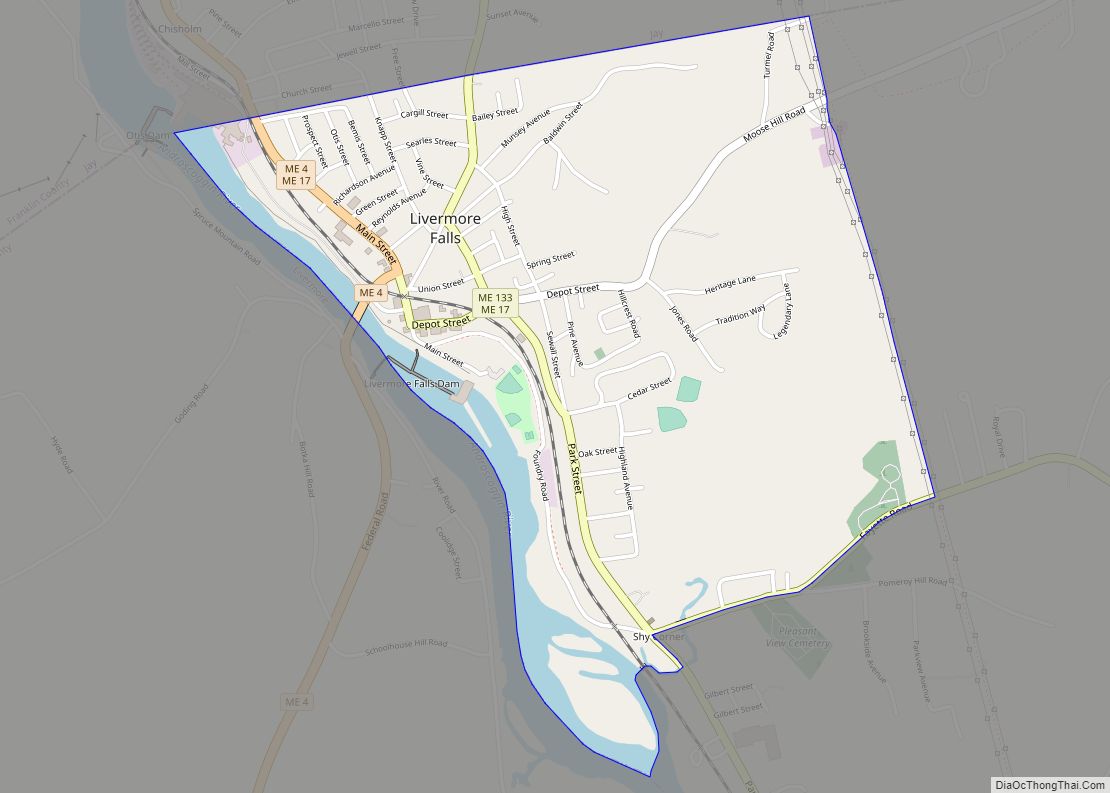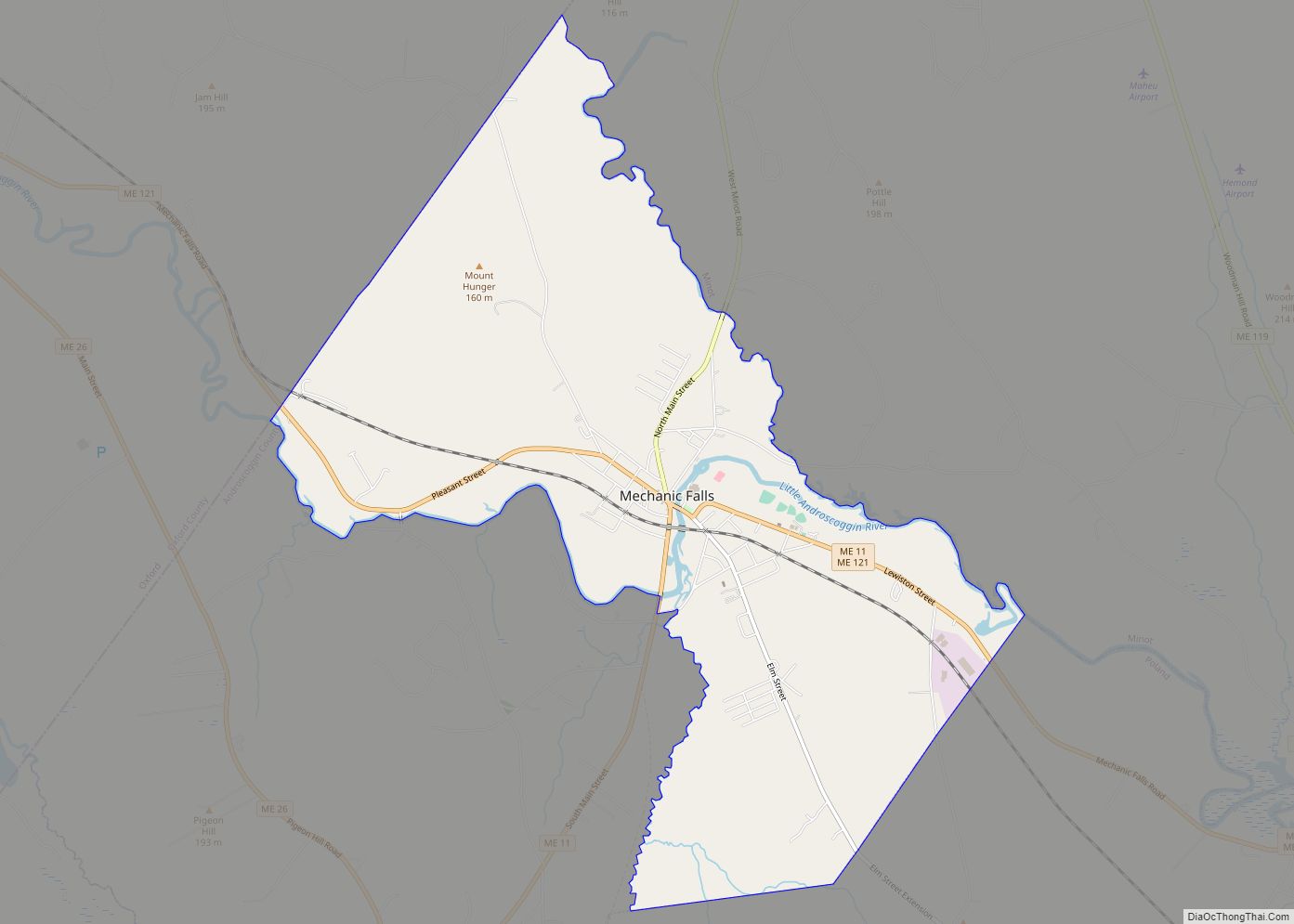Lewiston (/ˈluːɪstən/; French: [luistɔ̃]; officially the City of Lewiston, Maine) is the second largest city in the U.S. state of Maine and the most central city in Androscoggin County. The city lies halfway between Augusta, the state’s capital, and Portland, the state’s most populous city. It is one-half of the Lewiston-Auburn Metropolitan Statistical Area, commonly referred to as “L/A.” or “L-A.” Lewiston exerts a significant impact upon the diversity, religious variety, commerce, education, and economic power of Maine. It is known for an overall low cost of living, substantial access to medical care, and a low violent-crime rate. In recent years, the city of Lewiston has also seen a spike in economic and social growth. While the dominant language spoken in the city is English, it is home to a significant Somali population as well as the largest French-speaking population in the United States (by population) while it is second to St. Martin Parish, Louisiana, in percentage of speakers.
The Lewiston area traces its roots to 1669 with the early presence of the Androscoggin tribe (the namesake of the county in which the city resides). In the late 18th century, in 1795, Lewiston was incorporated as Lewistown. The presence of the Androscoggin River and Lewistown Falls made the town an attractive area for manufacturing and hydro-power businesses. The rise of Boston rail and textile tycoon Benjamin Bates saw rapid economic growth rivaling that of Cambridge, Worcester, and Concord. Irish immigrants were recruited to build the railroad links and dig the canals for the textile mills. The Irish stayed, and worked the mills and established flourishing businesses, as evidenced by the McGillicuddy, Callahan, and other Blocks and the St.Joseph’s and St.Patrick’s churches. In the 1850 Census Lewiston was fully 23% Irish born. The increase in economic stimulus prompted thousands of Quebecers to migrate, causing a population boom; the populace rose from 1,801 in 1840 to 21,701 in 1890. In 1855, local preacher Oren Burbank Cheney founded the Maine State Seminary, the first coeducational university in New England and one of the first universities to admit black students before the Emancipation Proclamation. Lewistown quickly became associated with the liberal arts and was incorporated as “Lewiston” in 1864, a year before the college was chartered as Bates College.
The city is home to the only basilica in Maine, Basilica of Saints Peter and Paul; 5 colleges and universities; 44 listings on the National Register of Historic Places; the Androscoggin Bank Colisée; the Stephens Observatory; the Olin Arts Center; the Bates College Museum of Art (BCMoA); and two significant general hospitals: Central Maine Medical Center and Saint Mary’s Regional Medical Center. The city’s population was 37,121 at the 2020 United States Census.
| Name: | Lewiston city |
|---|---|
| LSAD Code: | 25 |
| LSAD Description: | city (suffix) |
| State: | Maine |
| County: | Androscoggin County |
| Incorporated: | 1795 (as Lewistown) 1863 (as Lewiston) |
| Elevation: | 217 ft (66 m) |
| Total Area: | 35.54 sq mi (92.03 km²) |
| Land Area: | 34.15 sq mi (88.44 km²) |
| Water Area: | 1.39 sq mi (3.60 km²) 4% |
| Total Population: | 37,121 |
| Population Density: | 1,087.13/sq mi (419.74/km²) |
| Area code: | 207 |
| FIPS code: | 2338740 |
| Website: | www.lewistonmaine.gov |
Online Interactive Map
Click on ![]() to view map in "full screen" mode.
to view map in "full screen" mode.
Lewiston location map. Where is Lewiston city?
History
Conception
Prior to European colonization, the region of Lewiston was inhabited by the Androscoggin, an Abenaki people. During the 17th century, Androscoggin were among the first Native American tribes to make contact with European colonists in Maine. Tensions soon deteriorated over colonial expansion, and conflicts with colonists and epidemics of infectious diseases devastated the Androscoggin, which responded by migrating to New France from 1669 onwards. By 1680, the Androscoggin had been completely driven out of Maine. The governor of New France, Louis de Buade, allocated them two seigneuries on the Saint Francis River.
Colonial beginnings
A grant comprising the area of Lewiston was given to Moses Little and Jonathan Bagley, members of the Pejepscot Proprietors, on January 28, 1768, on the condition that fifty families live in the area before June 1, 1774. Bagley and Little named the new town Lewistown. Paul Hildreth was the first man to settle in Lewiston in the fall of 1770. By 1795, Lewiston was officially incorporated as a town. At least four houses that have survived from this period are currently listed on the National Register of Historic Places.
King Avenue and Ralph Avenue were named after Ralph Luthor King, who owned the land near the fairgrounds. Elliott Avenue was named after his wife, Grace O. Elliott, whose son eventually built the family home at 40 Wellman Street.
Industrial development and Benjamin Bates
Lewiston was a slow but steadily growing farm town throughout its early history. By the early-to-mid-19th century, however, as water power was being honed, Lewiston’s location on the Androscoggin River would prove to make it a perfect location for emerging industry. In 1809, Michael Little built a large wooden sawmill next to the falls. Burned in 1814 by an arsonist, it was later rebuilt. In 1836, local entrepreneurs—predominantly the Little family and friends—formed the Androscoggin Falls Dam, Lock & Canal Company:
The sales of stock attracted Boston investors—including Thomas J. Hill, Lyman Nichols, George L. Ward and Alexander De Witt. De Witt convinced textile and rail tycoon Benjamin Bates, then-President of the Union Pacific Railroad, to come to Lewiston and fund the emerging Lewiston Water Power Company. Soon after Bates arrived, the company created the first canal in the city. In the spring of 1850, some 400 Irish men recruited in and around Boston by construction contractor Patrick O’Donnell arrived in Lewiston and began work on the canal system. Impressed with the labor force and “working spirit” of the Lewistonions, Bates founded the Bates Manufacturing Company, leading to the construction of 5 mills starting with Bates Mill No. 1. In August 1850, Maine Governor John Hubbard signed the incorporation act and the mill was completed 1852. Bates positioned the mill in Lewiston due to the location of the Lewiston Falls which provided the mill with power. Under Bates’ supervision, during the Civil War, the mill produced textiles for the Union Army. His mills generated employment for thousands of Irish, Canadians, and immigrants from Europe. The mill was Maine’s largest employer for three decades.
This company began Lewiston’s transformation from a small farming town into a textile manufacturing center on the model of Lowell, Massachusetts. The creation of the Bates manufacturing trusts saw rapid economic growth, positioning the city as the wealthiest city in Maine, and created budding affluent districts such as the Main Street–Frye Street Historic District. Although the odd-majority of the population was working class, a distinctive upper class emerged at this time. The Bates Mill remained the largest employer in Lewiston from the 1850s to the mid-late 20th century.
Railroad construction was key to the development of both Lewiston and its neighbor, Auburn. In 1849, the Androscoggin & Kennebec railroad, running through Lewiston and Auburn, connected these towns to Waterville and the St. Lawrence & Atlantic Railway line between Portland, Maine, and Montreal, Quebec. The Androscoggin & Kennebec Railroad was constructed by Irish laborers, many of whom joined the Lewiston canal construction crews in 1850. The Irish laborers and their families lived in shanty-town neighborhoods called “patches”. By 1854, one quarter of Lewiston’s population was Irish, the highest concentration in any settlement in Maine. Subsequently, trains connected Quebec with Lewiston on a daily schedule. During the Civil War, the high demand for textiles helped Lewiston develop a strong industrial base through the Bates Enterprise. However, the concentration of wealth in Benjamin Bates sparked the 1861 Lewiston cotton riots which prompted him to give thousands of dollars back to the city and expand the employment opportunities at his mills. In 1861, a flood of French-Canadian immigration into Maine began, spawned by industrial work opportunities in Maine cities with water power from waterfalls. This brought a significant influx of Québécois millworkers who worked alongside Irish immigrants and Yankee mill girls. Lewiston’s population boomed between 1840 and 1890 from 1,801 to 21,701. Canadiens settled in an area downtown that became known as Little Canada, and Lewiston’s character has remained largely Franco-American ever since. In 1855, a Maine preacher traveled from Parsonsfield to Lewiston to establish an institution of higher learning in the city. In 1855, the Maine State Legislature was petitioned by Lewiston locals to found the Maine State Seminary. The school opened in 1855, and educated the working class of Maine while also providing education for blacks and women at a time when other universities barred their entrance. At its founding, it became the first coeducational college in New England and one of the earliest proponents of abolitionism.
During this time, in 1863, Lewiston was incorporated as a city. In 1872, St. Peter’s church was built in Lewiston. This was the first French-Canadian national church in Maine. In 1864, the Maine State Seminary was renamed Bates College in honor of Benjamin Bates.
In 1880, Le Messager, a French-language newspaper, began printing in Lewiston to serve its predominant ethnic population. The local Kora Shrine was organized in 1891 and held its first meetings in a Masonic temple on Lisbon Street. This group would from 1908 to 1910 build the Kora Temple on Sabattus Street, the largest home of a fraternal organization in the state. Architect George M. Coombs designed this Moorish-style structure.
City leaders decided to build a cathedral to which the Roman Catholic Diocese of Portland could relocate. Construction of the Church of Saints Peter and Paul began in 1905 and ended in 1938, funded mostly through thousands of small donations from Lewiston residents. It is the largest Roman Catholic Church in Maine, and Lewiston’s most prominent landmark. While the Diocese of Portland did not relocate to Lewiston, the church nevertheless became a basilica in 2004. It is one of the few American basilicas outside of a major metropolitan area.
Lewiston-Auburn Shoe Strike
In 1937, one of the largest labor disputes in Maine history occurred in Lewiston and Auburn. The Lewiston-Auburn Shoe Strike lasted from March to June and at its peak involved 4,000 to 5,000 workers on strike. After workers attempted to march across the Androscoggin River from Lewiston to Auburn, Governor Lewis Barrows sent in the Maine Army National Guard. Some labor leaders, among them CIO Secretary Powers Hapgood, were imprisoned for months after a Maine Supreme Judicial Court judge issued an injunction seeking to end the strike.
Textile investment
After World War I, profits from the textile industry in New England mill towns such as Lewiston; Biddeford; Manchester, New Hampshire; Waterbury, Connecticut; and Fall River, Haverhill, Lawrence and Lowell, Massachusetts began to decline. Businesses began moving to the South due to lower costs of power from more modern technologies (Lewiston’s water wheel technology gave way to hydroelectricity, cheaper transportation (as most cotton and materials came from the South), and cheaper labor).
Starting in the late 1950s, many of Lewiston’s textile mills began closing. This gradually led to a run-down and abandoned downtown area. Chain stores located downtown—Woolworth’s, W. T. Grant, S. S. Kresge, JC Penney and Sears Roebuck—shut their doors or moved to malls on the outskirts of Lewiston or Auburn. The city’s flagship department store, the four-story B. Peck & Co., closed in 1982 after more than a century in business. As businesses and jobs began to leave the city, people followed. The population stopped increasing at its previous rate and began to slowly decline after 1970, then at a greater rate in the 1990s.
Economic diversification and renaissance
After a difficult economic period in the 1980s that saw high unemployment and downtown stagnation, several key events have led to economic and cultural growth, including the transformation of the historic Bates Mill Complex. Because the city took over the complex in 1992 after back taxes went unpaid, years of taxpayer frustration in the city’s need to maintain the 1.1-million-square-foot (100,000 m) behemoth led to two referendums (one non-binding vote, the other binding). Voters soundly supported the need to pursue redevelopment by maintaining the property and selling it to private developers. In 2001, the city sold three mill buildings to local developers. In 2003, Platz Associates sold the Bates Mill Complex, with the exception of Mill 5 and a small support building. For the next four years, a number of business enterprises expanded after Platz redeveloped the mill building. The Bates Mill complex was listed on the National Register of Historic Places in December 2010.
In May 2004, the city officials announced a plan for urban renewal near the downtown area. The plan was to demolish several blocks of 19th-century millworker housing, lay new streets with updated infrastructure, construct more owner-occupied, lower-density housing, and build a boulevard through one neighborhood using federal Community Development Block Grant funds provided over a period of ten years. Some residents of the affected neighborhoods felt that the plan was initially announced with little input from them. They formed a neighborhood group called “The Visible Community”, which has since been actively involved in the planning process, and resulted in cooperation between neighbors and city officials to redesign Kennedy Park, including input on the location of new basketball courts, and feedback regarding creation of the largest all-concrete skate park in Maine.
Downtown is home to a new headquarters for Oxford Networks, along with a $20-million upgrade in local fiber-optics, a new auto parts store, a campus of the for-profit Kaplan University, the headquarters for Northeast Bank, a parking garage, and the newly renovated Maine Supply Co. building, listed on the National Register of Historic Places. That facility is now called the Business Service Center at Key Bank Plaza, and is home to the local Chamber of Commerce, the Lewiston-Auburn Economic Growth Council, and an arrangement with a number of business service providers.
The area’s renaissance has gained local, regional, and national recognition. In 2002 and again in 2006, the L-A area led the state in economic development activity, according to the Maine Department of Economic and Community Development’s list of business investments and expansions. In a 2006 KPMG International study measuring the cost of locating and maintaining a business, Lewiston ranked first among the New England communities analyzed, and finished 24th out of 49 U.S. communities analyzed.
Lewiston earned a 2007 All-America City Award designation by the National Civic League. The national competition “recognizes communities whose residents work together to identify and tackle community-wide challenges and achieve measurable, uncommon results.” 10 cities are selected as All-America Cities each year.
In 2017, Forbes Magazine named Lewiston one of its top 25 places to retire, citing relatively low cost of living, good access to medical care, and extremely low violent crime rate.
Somali and Bantu migration
In 1999, the United States government began preparations to resettle an estimated 12,000 refugees from Somalia to select cities throughout the United States. Most of the early arrivals in the United States settled in Clarkston, Georgia, a city adjacent to Atlanta. However, they were mostly assigned to low-rent, poverty-stricken inner-city areas, so many began to look to resettle elsewhere in the U.S.
Word soon spread that Lewiston had a low crime rate, good schools and cheap housing. In 1999, ethnic Somalis subsequently began a secondary migration from other states to the former mill town, and after 2005, many Somali Bantus, a separate ethnicity, followed suit.
In October 2002, then-Mayor Laurier T. Raymond wrote an open letter addressed to leaders of the Somali community, predicting a negative impact on the city’s social services and requesting that they discourage further relocation to Lewiston. The letter angered some persons and prompted some community leaders and residents to speak out against the mayor, drawing national attention. Demonstrations were held in Lewiston, both by those who supported the immigrants’ presence and those who opposed it.
In January 2003, about 32 members of a white nationalist group from Illinois demonstrated in Lewiston to denounce Somali immigrants. This prompted a simultaneous counter-demonstration on the campus of Bates College to demonstrate support of the Somali community. The rally repudiating the white nationalists attracted 4,000 attendees, including governor John Baldacci, Senators Olympia Snowe and Susan Collins and other officials. Mayor Raymond was reportedly out of town on vacation on the day of the protests.
In August 2010, the Lewiston Sun Journal reported that Somali entrepreneurs had helped reinvigorate downtown Lewiston by opening shops in previously closed storefronts. Amicable relations were also reported by the local Franco-American merchants and the Somali storekeepers.
Somali farmers have had a positive impact on Lewiston agriculture life. Farming was known to be “low caste” to Somalis, before they were forced to labor during slavery. Since migrating to Maine farming has become a part of life to some Somalis.
Somali-American players contributed to the Lewiston High School boys soccer team’s state championship wins in 2015, 2017, and 2018 under coach Mike McGraw.
National Register of Historic Places listings
- Androscoggin Mill Block
- Atkinson Building
- Bergin Block
- Bradford House
- Captain Holland House
- College Block-Lisbon Block
- Continental Mill Housing
- Cowan Mill
- Dominican Block
- Dr. Louis J. Martel House
- Dr. Milton Wedgewood House
- First Callahan Building
- First McGillicuddy Block
- First National Bank
- Grand Trunk Railroad Station
- Hathorn Hall, Bates College
- Healey Asylum
- Holland-Drew House
- James C. Lord House
- John D. Clifford House
- Jordan School
- Kora Temple
- Lewiston City Hall
- Lewiston Public Library
- Lewiston Trust and Safe Deposit Company
- Lord Block
- Lower Lisbon Street Historic District
- Lyceum Hall
- Maine Supply Company Building
- Manufacturer’s National Bank
- Marcotte Nursing Home
- Oak Street School
- Odd Fellows Block
- Osgood Building
- Pilsbury Block
- Philip M. and Deborah N. Isaacson House
- Saint Mary’s General Hospital
- Savings Bank Block
- Second Callahan Block
- Sen. William P. Frye House
- St. Joseph’s Catholic Church
- Basilica of Saints Peter and Paul
- Trinity Episcopal Church
- US Post Office-Lewiston Maine
- Union Block
Lewiston Road Map
Lewiston city Satellite Map
Geography
According to the United States Census Bureau, the city has a total area of 35.54 square miles (92.05 km), of which 34.15 square miles (88.45 km) is land and 1.39 square miles (3.60 km) is water. Lewiston is drained by the Androscoggin River, which forms its western border. The city is bordered by Auburn beyond the river, as well as the towns of Greene, Sabattus, and Lisbon. It is between Portland, the state’s largest city and cultural center, and the state capital of Augusta.
Neighborhoods
Downtown Lewiston runs from Oxford Street up to Jefferson Street, and from Adams Avenue to Main Street. This is the city’s most densely settled area, home to about half the population. It contains mostly housing, although on Lisbon Street and Main Street, it is entirely businesses. This neighborhood was once the commercial hub of the whole county, but with the city’s economic decline, many downtown stores closed and the former mill housing became run-down, resulting in fallen land values. But like many post-industrial centers, there has followed a period of renovation and revitalization that continues today.
This neighborhood includes:
- Lisbon Street Business District
- Country Kitchen Bread Factory
- Tree Street Youth Center
- Lewiston City Hall
- Lewiston Public Library
- Bates Mill Complex
- The Root Cellar
- Kennedy Park
- The Public Theatre
- S.S. Peter and Paul Basilica
- Agora Grand Event Center, formerly St. Patrick’s Church
- St. Joseph’s Church
- Central Maine Medical Center
- Railroad Park
- Androscoggin Bank Colisée
- Webb’s Market
- Farmers Market
Consisting mostly of suburban mid-income housing, this neighborhood runs between Lisbon and Webster Streets, East Avenue, and Alfred Plourde Parkway. Schools that serve this neighborhood are Farwell Elementary, Martel Elementary, Lewiston Middle School, and Lewiston High School.
This neighborhood is bounded by the triangle formed by Pond Road, Randall Road, and Sabattus Street (Route 126). This neighborhood is mostly mid-income suburban residential. McMahon Elementary, Lewiston Middle School, and Lewiston High School serve the area.
Climate
Lewiston has a humid continental climate, with very significant temperature variation throughout the year. Summers are usually short, warm, and humid, while winters tend to be very cold, long, and snowy. Lewiston averages 74 inches (190 cm) of snow annually, although this number varies greatly from winter to winter. Snow tends to be the dominant form of precipitation between late November and late March, although freezing rain, sleet, and rain can also occur in the winter when large low pressure systems track directly over or west of the city. Summer in Lewiston typically consists of pleasant temperatures, although high humidity can make the temperature feel more uncomfortable at times. Severe summertime storms, such as tornadoes and tropical cyclones are rare, but not unheard of.
See also
Map of Maine State and its subdivision: Map of other states:- Alabama
- Alaska
- Arizona
- Arkansas
- California
- Colorado
- Connecticut
- Delaware
- District of Columbia
- Florida
- Georgia
- Hawaii
- Idaho
- Illinois
- Indiana
- Iowa
- Kansas
- Kentucky
- Louisiana
- Maine
- Maryland
- Massachusetts
- Michigan
- Minnesota
- Mississippi
- Missouri
- Montana
- Nebraska
- Nevada
- New Hampshire
- New Jersey
- New Mexico
- New York
- North Carolina
- North Dakota
- Ohio
- Oklahoma
- Oregon
- Pennsylvania
- Rhode Island
- South Carolina
- South Dakota
- Tennessee
- Texas
- Utah
- Vermont
- Virginia
- Washington
- West Virginia
- Wisconsin
- Wyoming
